|
(Table1)
1-1. The characters for the notes are formed from dots 1, 2, 4, & 5. The
absence or presence of dots 3 and/or 6 determines the note values. Each
note or rest has two value possibilities.
Signs from Table 1 A.
| C |
D |
E |
F |
G |
A |
B |
Rest |
Type |
 |
 |
 |
 |
 |
 |
 |
 |
Wholes or 16ths |
 |
 |
 |
 |
 |
 |
 |
 |
Halves or 32nds |
 |
 |
 |
 |
 |
 |
 |
 |
Quarters or 64ths |
 |
 |
 |
 |
 |
 |
 |
 |
8ths or 128ths |
  Prefix for 256th notes, i.e., Prefix for 256th notes, i.e.,        (etc.) (etc.)
  Distinction of values Distinction of values

 Separation of rhythmic groups Separation of rhythmic groups


 Larger values; 8ths and larger Larger values; 8ths and larger


 Smaller values; 16ths and smaller Smaller values; 16ths and smaller



 Brevis, i.e., Brevis, i.e.,


 (etc.) (etc.)



 Brevis rest Brevis rest
1-2. For dotted notes, dot 3 represents each print dot following a note. It is placed immediately after the braille note. No other sign comes between the note and its dot(s). Dotted rests are treated the same as dotted notes.Esample 1-2 is in four-four time. The measure ends with a double bar sign:   . .
Example 1-2
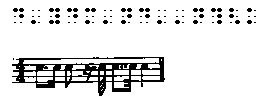
1-3. The sign for 256th notes is used as a prefix and is followed by 16th notes
or rests. When a note or rest of different value intervenes, the prefix is repeated before
the next 256th note.
1-4. When the value of a note is not apparent form the number of notes and rests in the measure, the general
sign for distinction of values or specific signs for small and large value are used. Example 1-4 is in four-four
time;a space is a bar line. In (a), the distinction of value sign is placed between a half note and the four
32nd notes that follow it. In (b) the specific sign for smaller value is used.
Example 1-4.
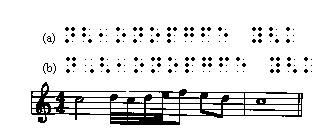
1-5. One of the uses for the smaller value sign ocurs when it is not clear whether the first note of a piece has a smaller or larger value.
Example 1-5 begins with an anacrusis to the four-four measures.
Example 1-5

1-6. Large and small value signs are expecialy useful in cadenzas. They should
be used when ever a combination such as half notes and 32nd notes occur either in a cadenza
or a passage of measured music.
Example 1-6

1-7. THe whole rest is used for a complete measure of rest in any time value. For two or three consecutive measures of rest,
use form (a) below. For four or more measures of rest, use form (b). j when the square (brevis) rest appears in print, use form (c).
Example 1-7
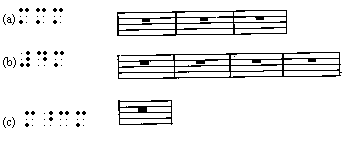
B. Octave Marks
1-8. Octave marks, rather than clefs on a staff, indicate specific pitch locations in braille music.
Octaves are numbered from one to seven, beginning with the lowest C on the normal, seen-octave piano.
Each octave begins on C and includes all the notes up to, but not including, the next C above. THe fourth
octave begins on the "middle C" of the piano. (Because of the number of "signs" in this manual, the origional
term, "mark", is used for the many references to octave marks throughout the manual.)
1-9. The octave mark is placed immediately before the note to which it applies with no intervening signs. Example 1-9
shows the octave marks from 1 to 7 placed before quarter-note C.
Example 1-9.
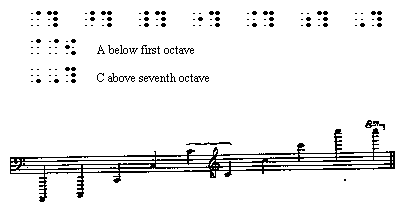
1-10. The first note of a piece must be preceded by its octave mark. For the succeeding notes the following rules
apply:
(a) if the next note forms an ascending or descending second or third,
it does not recieve an octave mark even if it is in a different octave.
(b) if it forms an ascending or descending fourth or fifth, it only recieves an octave mark
if it is in a different octave from the preceding note.
(c) if it forms a sixth or more, it must always have its own octave mark.
1-11. These rules are illustrated in the following example from the "Cologne Key"
of 1888.
Example 1-11.
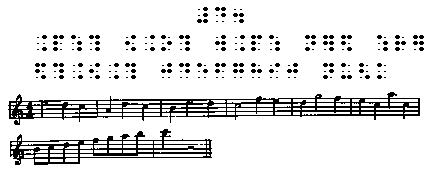
1-12. The example aboce contains a time signaature on the first line cosisting of a number 4 in normal
cell-position followed by a number 4 in lower-cell position to represent 4/4 time.
Each measure of four beats is separated by a space, representing the print bar-line.
1-13. When the print contains "8va" and "loco" the first note of the "8va"
(or "eba") should receive two octave marks, the marks, the first showing its position on
the print staff and the second showing its actual sound. Any octave marks necessary during the passage
must show the actual sound. The first note after the end of the passage is given a double octave mark
to show that its position os the staff corresponds to its actual sound.
Example 1-13 illustrates this technique for transcribing "8va" and "loco".
Example 1-13

| |